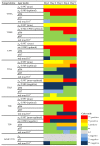Characterization of Indoor Molds after Ajka Red Mud Spill, Hungary
- PMID: 38251330
- PMCID: PMC10820486
- DOI: 10.3390/pathogens13010022
Characterization of Indoor Molds after Ajka Red Mud Spill, Hungary
Abstract
A red mud suspension of ~700,000 m3 was accidentally released from the alumina plant in Ajka, Hungary, on the 4th of October 2010, flooding several buildings in the nearby towns. As there is no information in the literature on the effects of red mud on indoor mold growth, we conducted studies to answer the following question: does the heavy metal content of red mud inhibit fungal colonization in flooded houses? In order to gain knowledge on fungal spectra colonizing surfaces soaked with red mud and on the ability of fungi to grow on them, swabs, tape lifts, and air samples were collected from three case study buildings. A total of 43 fungal taxa were detected. The dominant species were Penicillium spp. on plaster/brick walls, but Aspergillus series Versicolores, Cladosporium, Acremonium, and Scopulariopsis spp. were also present. The level of airborne penicillia was high in all indoor samples. Selected fungal strains were subcultured on 2% MEA with 10-1 and 10-4 dilutions of red mud. The growth rate of most of the strains was not significantly reduced by red mud on the artificial media. The consequences of similar industrial flooding on indoor molds are also discussed in this paper.
Keywords: bauxite processing residue; fungal growth; indoor mold; red mud.
Conflict of interest statement
The authors declare no conflicts of interest.
Figures


Similar articles
-
[Airborne fungal community composition in indoor environments in Beijing].Huan Jing Ke Xue. 2013 May;34(5):2031-7. Huan Jing Ke Xue. 2013. PMID: 23914564 Chinese.
-
Characterization of airborne molds, endotoxins, and glucans in homes in New Orleans after Hurricanes Katrina and Rita.Appl Environ Microbiol. 2007 Mar;73(5):1630-4. doi: 10.1128/AEM.01973-06. Epub 2007 Jan 5. Appl Environ Microbiol. 2007. PMID: 17209066 Free PMC article.
-
[Investigation of mold fungi in air samples of elementary schools and evaluation of allergen-specific IgE levels in students' sera].Mikrobiyol Bul. 2012 Apr;46(2):266-75. Mikrobiyol Bul. 2012. PMID: 22639315 Turkish.
-
Can we use indoor fungi as bioindicators of indoor air quality? Historical perspectives and open questions.Sci Total Environ. 2010 Sep 15;408(20):4285-95. doi: 10.1016/j.scitotenv.2010.07.005. Epub 2010 Jul 23. Sci Total Environ. 2010. PMID: 20655574 Review.
-
Adverse human health effects associated with molds in the indoor environment.J Occup Environ Med. 2003 May;45(5):470-8. doi: 10.1097/00043764-200305000-00006. J Occup Environ Med. 2003. PMID: 12762072 Review.
Cited by
-
Dysbiosis in the Nasal Mycobiome of Infants Born in the Aftermath of Hurricane Maria.Microorganisms. 2025 Jul 31;13(8):1784. doi: 10.3390/microorganisms13081784. Microorganisms. 2025. PMID: 40871288 Free PMC article.
References
-
- Hind A.R., Bhargava S.K., Grocott S.C. The Surface Chemistry of Bayer Process Solids: A Review. Colloids Surf. A Physicochem. Eng. Asp. 1999;146:359–374. doi: 10.1016/S0927-7757(98)00798-5. - DOI
-
- Announcement of MAL Hungarian Aluminium. [(accessed on 3 November 2023)]. Available online: http://english.mal.hu/engine.aspx?page=showcontent&content=Vorosiszap_HI....
MeSH terms
Substances
LinkOut - more resources
Full Text Sources
Medical
Research Materials
Miscellaneous

